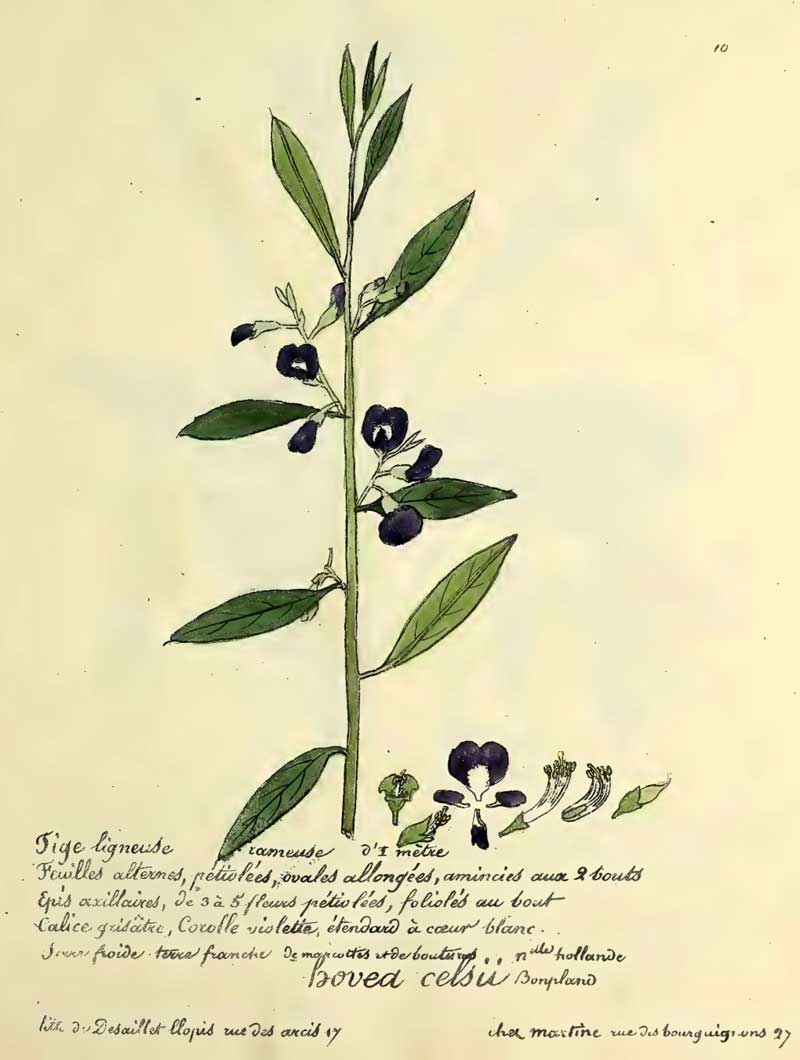
Classification System: APG IV
Superregnum: Eukaryota
Regnum: Plantae
Cladus: Angiosperms
Cladus: Eudicots
Cladus: Core eudicots
Cladus: Rosids
Cladus: Eurosids I
Ordo: Fabales
Familia: Fabaceae
Subfamilia: Faboideae
Tribus: Brongniartieae
Genus: Hovea
Species: Hovea elliptica
Name
Hovea elliptica (Sm.) DC., Prodr. 2: 115. 1825.
Synonyms
Goodia simplicifolia Spreng.
Hovea celsii Bonpl.
Hovea latifolia G.Lodd.
Phusicarpos ellipticus (Sm.) Poir.
Platychilum celsianum Loisel.
Poiretia elliptica Sm.
Homonyms
Hovea elliptica Meisn. = Hovea trisperma Benth.
Distribution
Native distribution areas:
Continental: Australasia
Regional: Australia
Western Australia
References: Brummitt, R.K. 2001. TDWG – World Geographical Scheme for Recording Plant Distributions, 2nd Edition
References
Primary references
De Candolle, A.P. 1825. Ordo LXIII. Leguminosae. Pp. 93–524 in Prodromus systematis naturalis regni vegetabilis, sive enumeratio contracta ordinum, generum, specierumque plantarum huc usque cognitarum, juxta methodi naturalis normas digesta, Pars 2, Sistens Calyciflorarum ordines X. Treuttel et Würtz, Parisiis [Paris]. BHL Reference page.
Links
USDA, ARS, Germplasm Resources Information Network. Hovea elliptica in the Germplasm Resources Information Network (GRIN), U.S. Department of Agriculture Agricultural Research Service. Accessed: 09-Oct-10.
Hovea elliptica – Taxon details on National Center for Biotechnology Information (NCBI).
Tropicos.org 2018. Hovea elliptica. Missouri Botanical Garden. Published online. Accessed: 17 January 2018.
Hovea elliptica in: Australian Plant Census (APC) 2018. IBIS database, Centre for Australian National Biodiversity Research, Council of Heads of Australasian Herbaria. Accessed: 2018 January 18.
International Plant Names Index. 2018. Hovea elliptica. Published online. Accessed: 18 January 2018.
Vernacular names
Hovea elliptica, commonly known as the tree hovea[2] or karri blue bush,[3] is an ornamental plant in the family Fabaceae that is native to Western Australia. This plant was cited as Hovea Celsi in Description des plantes rares cultivees a Malmaison et a Navarre by Aimé Jacques Alexandre Bonpland.
Description
The erect and slender shrub or small tree typically grows to a height of 0.4 to 3 metres (1 to 10 ft).[2] It is usually single stemmed and the young branches are covered in spreading often rust coloured hairs. The stipules are narrow triangular and around 1 millimetre (0.039 in) in length.[4] The alternately arranged leaves have an elliptical blade to around 7.5 centimetres (3.0 in) in length.[5] The species has purple or blue flowers that appear between August and December in its native range.[2] The pea shaped flowers are arranged in short clusters among the leaf axils.[5] The axillary inflorescences contain one to seven flowers. The seed pods that form later are ovoid to ellipsoid in shape and are 0.8 to 1.2 cm (0.31 to 0.47 in) in length and 0.8 to 1.3 cm (0.31 to 0.51 in) wide. The olive brown seeds within have an elliptic shape and 3.8 to 5.1 mm (0.15 to 0.20 in) in length and 2.8 to 3.1 mm (0.11 to 0.12 in) wide.[4]
Taxonomy
The species was first formally in 1808 as Poiretia elliptica by James Edward Smith in 1808 in the work Characters of Platylobium, Bossiaea and of a new Genus named Poiretia as published in Transactions of the Linnean Society of London. It was later transferred to the genus Hovea by the botanist Augustin Pyramus de Candolle in 1825 in the work Leguminosae. Prodromus Systematis Naturalis Regni Vegetabilis. Numerous synonyms are known including Goodia simplicifolia as described by Kurt Polycarp Joachim Sprengel in 1827, Phusicarpos elliptica by Jean Louis Marie Poiret in 1816 and Platychilum celsianum by Jean-Claude Michel Mornant de Launay in 1819.[6]
Distribution
It occurs on sand dunes, slopes ridges and granite outcrops in the South West and Great Southern regions of Western Australia where it grows in clay, loamy, sandy and gravelly lateritic soils[2] often rich in organic matter.[4] Usually part of the understorey in jarrah, marri and karri forest communities[5] and is often associated with Bossiaea aquifolium subsp. laidlawiana and Hovea chorizemifolia.[4]
Cultivation
It is sold commercially as seedlings or in seed form, the seeds germinate readily but need to be scarified or pre-treated with boiling water.[5] The plant prefers well-drained soils and an open sunny or partly shaded position.[3] It is drought tolerant but frost tender.[5]
References
"Hovea elliptica". Australian Plant Name Index (APNI), IBIS database. Centre for Plant Biodiversity Research, Australian Government, Canberra. Retrieved 2009-08-02.
"Hovea elliptica". FloraBase. Western Australian Government Department of Biodiversity, Conservation and Attractions.
"Karri Blue Bush (Hovea elliptica)". Gardenworld. Retrieved 21 September 2018.
J.H.Ross. "Notes on Hovea" (PDF). Royal Botanic Gardens, Victoria. Retrieved 21 September 2018.
"Hovea elliptica". Australian Seed. Retrieved 21 September 2018.
"Hovea elliptica (Sm.) DC". Atlas of Living Australia. Global Biodiversity Information Facility. Retrieved 21 September 2018.
Bonpland, A. J. A. (1813). Description des plantes rares cultivees a Malmaison et a Navarre.
Pink, A. (2004). Gardening for the Million. Project Gutenberg Literary Archive Foundation.
Rowan, E. (c. 1906). Flower and bird paintings. National Library of Australia.
Retrieved from "http://en.wikipedia.org/"
All text is available under the terms of the GNU Free Documentation License

